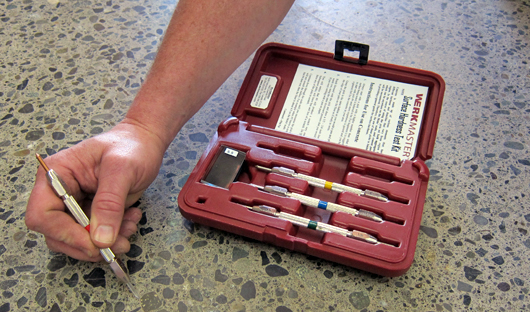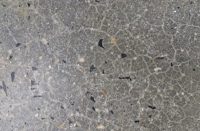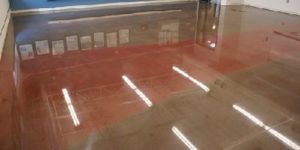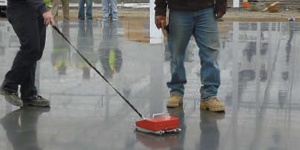
Photos courtesy of WerkMaster
In an earlier concrete polishing tip, I mentioned there are many options when choosing diamond tooling configurations and grit levels. Now we’re going to learn about another variable to consider, the Mohs testing for polished concrete.
Today, we’ll learn how to match a diamond tool’s metal bond to the concrete prior to choosing the grit level. We will do this by correctly performing a Mohs hardness test.
The question is: How hard is the concrete you’ll be polishing and what metal-bond diamond tooling should you use for your first grind?
Doing a Mohs test prior to every first cut done dry will save time, money and improve productivity.
Learning
- The kit comes with tester pieces, which are small thin rectangular pieces of different materials that scratch on different levels. There is a mark on each piece as to which level that is.
- The objective is to use these pieces to first train your hand to use the correct amount of pressure with these guides. Then test a floor.
- Hold the tool like a pencil, press the point into the tester piece. Then pull it forward to draw a line. When it makes a scratch, remember the amount of pressure used. Try it again until it feels natural.
Testing
- Now, hold the tool like a pencil and press the point of the #9 tester on the concrete surface and pull a line. Note mentally how much it scratched.
- When the tool leaves an etched line in the surface, it indicates that the floor is softer than the numbered tool just used.
- Continue to progress down in numbers until the numbered tool you’re using doesn’t scratch.
- Your answer will be the previous number of the one that didn’t scratch the concrete surface.
- If there is a questionable result, test another fresh/clean area of the concrete surface to establish the hardness of the floor on average. Then use the corresponding color metal-bond diamond tool to open the floor.
- Repeat the hardness test before each step if needed. This can be useful. Many times the cap is harder than the slab’s matrix. So, that bond color/hardness will abrade the softer bond diamond that was required to get through that hard cap resulting in excessive wear of that tooling.
Remember this simple rule: Use harder bond for softer concrete and softer bond for harder concrete
Have more questions or a suggestion for polished concrete topics? Feel free to contact Jennifer Faller at [email protected].















